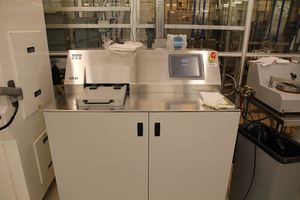Molecular Vapor Deposition: Difference between revisions
Jump to navigation
Jump to search
Content deleted Content added
No edit summary |
link to nanoimprint FDTS recipe |
||
| Line 12: | Line 12: | ||
= About = |
= About = |
||
The Molecular Vapor deposition system is used for deposition of a monolayer-thick fluorocarbon film for producing extremely hydrophobic surfaces used for anti-sticking layers for nanoimprinting or anti-stiction layers for MEMS. The system has integrated Oxygen plasma cleaning for organic removal and surface activation and can be run at temperatures up to 80°C. Multi-step recipes can be created. The system is currently configured for FDTS (perflourodecyltricholorsilane) and water to producing the coatings. Up to 6” wafers can be coated in the system. |
The Molecular Vapor deposition system is used for deposition of a monolayer-thick fluorocarbon film for producing extremely hydrophobic surfaces used for anti-sticking layers for nanoimprinting or anti-stiction layers for MEMS. The system has integrated Oxygen plasma cleaning for organic removal and surface activation and can be run at temperatures up to 80°C. Multi-step recipes can be created. The system is currently configured for FDTS (perflourodecyltricholorsilane) and water to producing the coatings. Up to 6” wafers can be coated in the system. |
||
== Recipes == |
|||
* [https://www.nanotech.ucsb.edu/wiki/index.php/Lithography_Recipes#Nanoimprinting_Recipes Nanoimprinting recipes] using FDTS non-stick layer |
|||
Revision as of 03:25, 11 May 2018
| ||||||||||||||||||||
About
The Molecular Vapor deposition system is used for deposition of a monolayer-thick fluorocarbon film for producing extremely hydrophobic surfaces used for anti-sticking layers for nanoimprinting or anti-stiction layers for MEMS. The system has integrated Oxygen plasma cleaning for organic removal and surface activation and can be run at temperatures up to 80°C. Multi-step recipes can be created. The system is currently configured for FDTS (perflourodecyltricholorsilane) and water to producing the coatings. Up to 6” wafers can be coated in the system.
Recipes
- Nanoimprinting recipes using FDTS non-stick layer
